Tips for laying laminate on uneven floors
Many, choosing a laminate as a new floor covering, face a number of problems associated with its laying and further operation. In most cases, this is due to violations of the laying technology and manufacturer’s recommendations. Another major problem is the uneven base on which the coating is laid. In fact, the installation process itself is quite simple, but laying a laminate on an uneven floor will require additional effort and financial costs. To make everything go smoothly and with the least loss, there are a number of recommendations and tips for laying laminate on an uneven floor.
Content
- How to store laminate flooring
- Rough ground preparation
- How to level a wooden floor
- The method of leveling the concrete floor
How to store laminate flooring
After buying laminate sheets, it must be left for some time in the room where it will be laid. It is necessary for the laminate to accept the temperature and humidity level of the room, which directly affects its size. Storage lasts until the moment of installation. In this case, the laminate should remain in the package and be at a distance of more than 1 m from the walls. Manufacturers recommend adhering to the following regime: temperature not less than 18 ° С, humidity 75%.
Rough ground preparation
Manufacturers of floor coverings can guarantee the strength and durability of their products only if they have a well-prepared foundation. This applies to all floor coverings and, in particular, laminate flooring. Otherwise, the laminate may crack, swell, begin to make noise when walking and eventually burst. To prevent this from happening, it is necessary to prepare a good foundation.
Important! The difference in the unevenness of the floor can be 2 mm per 2 meters maximum. In this case, the laminate will serve for a long time. If there are more irregularities: depressions, crevices, pits, sagging, laminate locks may become loose within a few months, and then the sheet will crack.
Conclusion: the uneven floor will have to level.
How to level a wooden floor
If the laminate is laid on an old wooden floor, then it is necessary to check it for the following defects:
- floorboard failures;
- creak;
- cracks and cracks;
- bumps.
To eliminate the failures of the wooden floor, you will have to partially disassemble it. First, we disassemble to the subfloor, if dips are still present, then remove the subfloor, fix and align the logs. You can simply fix the rough floor to the logs using self-tapping screws, but in this case we risk getting a slight bias. The creaking elements of the wooden floor are fixed with screws. Putty cracks and cracks.
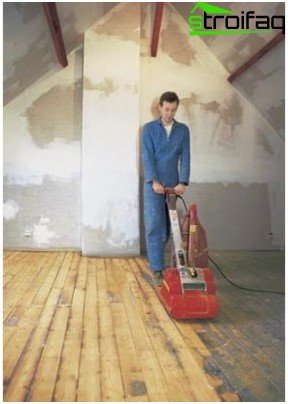
Wood floor cycling
For laying a laminate, these actions may not be enough, therefore, we eliminate differences and irregularities. One of the options for leveling a wooden floor is scraping. It can be done manually, although it’s hard, but you can use a looping machine and properly sand the surface.
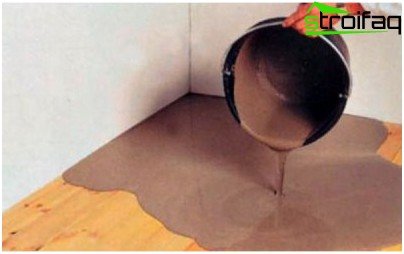
Fill the wooden floor with a self-leveling mixture
Another way to level the wooden floor is to fill the screed with a self-leveling mixture. The dry mixture is diluted in water and applied with a thin layer of 10 to 25 mm over the entire surface. This will provide a sufficiently flat surface so that the laminate does not warp or crack..
You can perform the so-called dry leveling: lay sheets of plywood or drywall on the floor surface. To do this, sheets from a thickness of 1.5 to 2 cm are used. But experts recommend using this method when the carpet or linoleum is the final coating. In the case of laying laminate, it is better to screed.
The method of leveling the concrete floor
If the laminate is laid on a concrete floor, it must be checked for the following defects:
- cracks and crevices;
- bumps.
Unlike a wooden floor, preparing a concrete base is much easier..
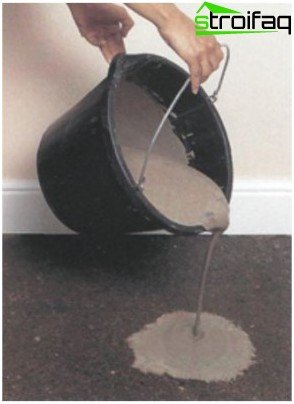
Pour the self-leveling mixture
The best option is a screed made of concrete or a self-leveling mixture. A concrete screed will require additional trouble: you have to wave a shovel and work with a concrete mixer. To fill a self-leveling mixture, you only need a mixture, water and a container. This greatly simplifies the task..
To level the concrete floor, sheets of plywood, chipboard or drywall are also used. This method is simpler and less labor intensive. But do not forget, for laying laminate it is more appropriate to perform a screed, since it will provide a sufficiently strong and even base.
Important! Laminate should be laid on a dry surface. If there is increased humidity of the wooden or concrete floor, it is necessary to carry out their full waterproofing. Then let the screed dry, only then lay the laminate.
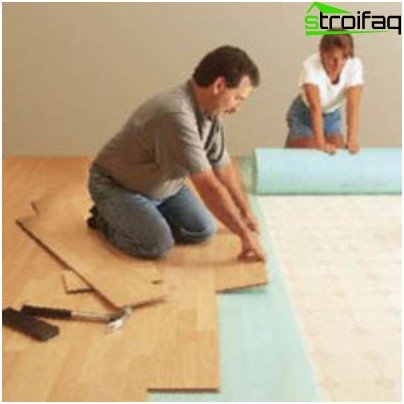
For sound insulation we make a foam polyethylene backing
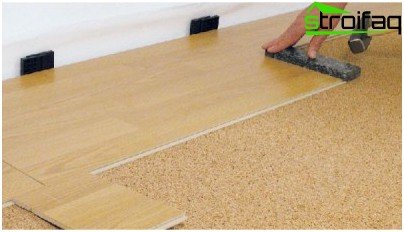
As a substrate, you can use a cork
To increase the noise insulation properties, strength and durability of the laminate, it is necessary to lay a substrate under it. It can be a cork or foamed polyethylene. The substrate should be fixed along the perimeter and along the diagonals so that it does not move out. In addition, the backing will provide a softer base for the laminate itself and help smooth out minor floor irregularities..
How to lay laminate flooring
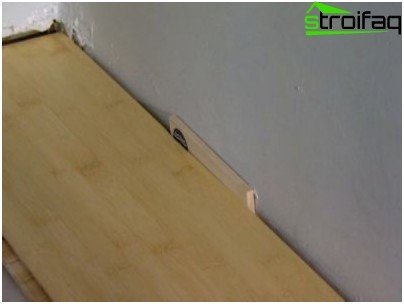
Leave 1 cm of clearance between the wall and the laminate
- a clearance of 1 cm must be left between the walls and the laminate for possible expansion of the laminate due to seasonal changes, moisture level and temperature;
- boards of the next row must be laid with a shift in relation to the previous row, the shift should be up to half of the board;
- in the case of pipes or other utilities, it is necessary to leave a gap of 1 cm between them and the laminate;
- laying the laminate on the glue, let it dry completely.
Laying a laminate on an uneven floor is a matter requiring attention to detail. But it’s easy to cope with, adhering to simple tips and recommendations of manufacturers.






